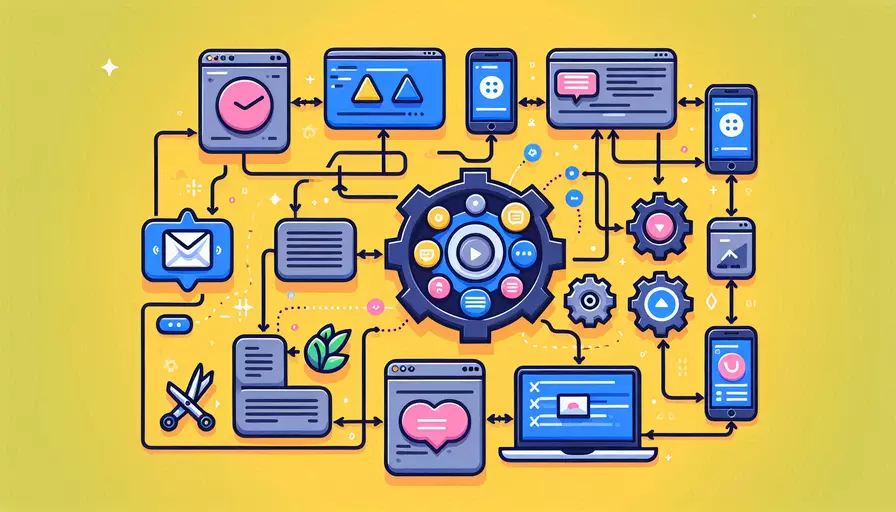
Vue组件间的通信主要有以下几种方式:1、父子组件通信;2、兄弟组件通信;3、跨级组件通信;4、全局状态管理。这些方法可以根据具体的应用场景和需求选择最合适的通信方式。下面将详细介绍这些通信方式及其实现方法。
一、父子组件通信
父子组件通信是Vue最常用的通信方式之一。父组件通过 props 向子组件传递数据,子组件通过 $emit 触发事件通知父组件。
-
父组件向子组件传递数据
父组件通过
props向子组件传递数据。父组件在模板中使用子组件,并通过属性绑定传递数据。<!-- ParentComponent.vue --><template>
<div>
<ChildComponent :message="parentMessage" />
</div>
</template>
<script>
import ChildComponent from './ChildComponent.vue';
export default {
components: {
ChildComponent
},
data() {
return {
parentMessage: 'Hello from Parent'
};
}
};
</script>
<!-- ChildComponent.vue --><template>
<div>
{{ message }}
</div>
</template>
<script>
export default {
props: {
message: {
type: String,
required: true
}
}
};
</script>
-
子组件向父组件传递数据
子组件通过
$emit触发事件,将数据传递给父组件。父组件在模板中监听子组件的事件,并在事件处理函数中接收数据。<!-- ParentComponent.vue --><template>
<div>
<ChildComponent @update-message="handleMessageUpdate" />
</div>
</template>
<script>
import ChildComponent from './ChildComponent.vue';
export default {
components: {
ChildComponent
},
methods: {
handleMessageUpdate(newMessage) {
console.log('Message from child:', newMessage);
}
}
};
</script>
<!-- ChildComponent.vue --><template>
<div>
<button @click="sendMessage">Send Message to Parent</button>
</div>
</template>
<script>
export default {
methods: {
sendMessage() {
this.$emit('update-message', 'Hello from Child');
}
}
};
</script>
二、兄弟组件通信
兄弟组件间的通信可以通过一个共同的父组件来实现,或者使用一个事件总线(Event Bus)。
-
通过共同的父组件
兄弟组件将数据传递给共同的父组件,再由父组件传递给另一个兄弟组件。
<!-- ParentComponent.vue --><template>
<div>
<SiblingOne @update-data="handleDataUpdate" />
<SiblingTwo :data="sharedData" />
</div>
</template>
<script>
import SiblingOne from './SiblingOne.vue';
import SiblingTwo from './SiblingTwo.vue';
export default {
components: {
SiblingOne,
SiblingTwo
},
data() {
return {
sharedData: ''
};
},
methods: {
handleDataUpdate(data) {
this.sharedData = data;
}
}
};
</script>
-
使用事件总线(Event Bus)
事件总线是一个空的 Vue 实例,可以在任何组件间传递事件和数据。
// EventBus.jsimport Vue from 'vue';
export const EventBus = new Vue();
<!-- SiblingOne.vue --><template>
<div>
<button @click="sendMessage">Send Message to SiblingTwo</button>
</div>
</template>
<script>
import { EventBus } from './EventBus.js';
export default {
methods: {
sendMessage() {
EventBus.$emit('update-data', 'Hello from SiblingOne');
}
}
};
</script>
<!-- SiblingTwo.vue --><template>
<div>
{{ message }}
</div>
</template>
<script>
import { EventBus } from './EventBus.js';
export default {
data() {
return {
message: ''
};
},
created() {
EventBus.$on('update-data', (data) => {
this.message = data;
});
}
};
</script>
三、跨级组件通信
跨级组件通信可以通过提供/注入(provide/inject)机制实现,或者使用 Vuex 进行全局状态管理。
-
提供/注入(provide/inject)
父组件通过
provide提供数据,子组件通过inject注入数据。<!-- GrandParentComponent.vue --><template>
<div>
<ParentComponent />
</div>
</template>
<script>
import ParentComponent from './ParentComponent.vue';
export default {
components: {
ParentComponent
},
provide() {
return {
message: 'Hello from GrandParent'
};
}
};
</script>
<!-- ParentComponent.vue --><template>
<div>
<ChildComponent />
</div>
</template>
<script>
import ChildComponent from './ChildComponent.vue';
export default {
components: {
ChildComponent
}
};
</script>
<!-- ChildComponent.vue --><template>
<div>
{{ message }}
</div>
</template>
<script>
export default {
inject: ['message']
};
</script>
-
使用 Vuex 进行全局状态管理
Vuex 是一个专为 Vue.js 应用设计的状态管理模式,可以实现任意组件间的状态共享。
// store.jsimport Vue from 'vue';
import Vuex from 'vuex';
Vue.use(Vuex);
export default new Vuex.Store({
state: {
message: ''
},
mutations: {
updateMessage(state, newMessage) {
state.message = newMessage;
}
}
});
<!-- ComponentA.vue --><template>
<div>
<button @click="sendMessage">Send Message to ComponentB</button>
</div>
</template>
<script>
export default {
methods: {
sendMessage() {
this.$store.commit('updateMessage', 'Hello from ComponentA');
}
}
};
</script>
<!-- ComponentB.vue --><template>
<div>
{{ message }}
</div>
</template>
<script>
export default {
computed: {
message() {
return this.$store.state.message;
}
}
};
</script>
四、全局状态管理
全局状态管理是指通过一个全局的状态管理工具(如 Vuex)来管理整个应用的状态,方便在不同组件之间共享数据。
-
安装 Vuex
使用 npm 或 yarn 安装 Vuex:
npm install vuex --saveyarn add vuex -
创建 Vuex Store
创建一个新的
store.js文件,并配置 Vuex Store:// store.jsimport Vue from 'vue';
import Vuex from 'vuex';
Vue.use(Vuex);
export default new Vuex.Store({
state: {
message: ''
},
mutations: {
updateMessage(state, newMessage) {
state.message = newMessage;
}
}
});
-
在 Vue 实例中引入 Vuex Store
// main.jsimport Vue from 'vue';
import App from './App.vue';
import store from './store';
new Vue({
store,
render: h => h(App)
}).$mount('#app');
-
在组件中使用 Vuex Store
<!-- ComponentA.vue --><template>
<div>
<button @click="sendMessage">Send Message to ComponentB</button>
</div>
</template>
<script>
export default {
methods: {
sendMessage() {
this.$store.commit('updateMessage', 'Hello from ComponentA');
}
}
};
</script>
<!-- ComponentB.vue --><template>
<div>
{{ message }}
</div>
</template>
<script>
export default {
computed: {
message() {
return this.$store.state.message;
}
}
};
</script>
总结来说,Vue组件间的通信方式多种多样,主要包括父子组件通信、兄弟组件通信、跨级组件通信和全局状态管理。选择合适的通信方式取决于具体的应用场景和需求。对于简单的父子组件通信,使用 props 和 $emit 即可;对于复杂的跨组件通信,建议使用 Vuex 进行全局状态管理。通过合理地选择和使用这些通信方式,可以让你的 Vue 应用更加高效和可维护。
相关问答FAQs:
1. Vue组件间如何进行父子组件通信?
在Vue中,父子组件之间的通信是比较常见的情况。可以通过props和$emit来实现父子组件之间的数据传递和事件通知。
-
父组件通过props向子组件传递数据:
- 在父组件中,在子组件的标签中通过属性的方式传递数据,例如:
<child-component :data="parentData"></child-component>。 - 在子组件中,通过props接收父组件传递的数据,例如:
props: ['data']。 - 子组件就可以在自己的模板中使用父组件传递的数据了。
- 在父组件中,在子组件的标签中通过属性的方式传递数据,例如:
-
子组件通过$emit触发事件向父组件传递数据:
- 在子组件中,通过
this.$emit('事件名', 数据)来触发一个事件,并将需要传递的数据作为参数传入。 - 在父组件中,通过监听子组件触发的事件来获取传递的数据,例如:
<child-component @事件名="handleEvent"></child-component>。 - 在父组件的方法中,可以通过参数来接收子组件传递的数据,例如:
handleEvent(data) { // 处理数据 }。
- 在子组件中,通过
2. Vue组件间如何进行兄弟组件通信?
在Vue中,兄弟组件之间的通信需要借助共同的父组件来实现。可以通过事件总线、Vuex或provide/inject等方式来实现兄弟组件之间的通信。
-
通过事件总线实现兄弟组件通信:
- 创建一个空的Vue实例作为事件总线,例如:
const bus = new Vue()。 - 在其中一个兄弟组件中,通过
bus.$emit('事件名', 数据)来触发一个事件,并将需要传递的数据作为参数传入。 - 在另一个兄弟组件中,通过
bus.$on('事件名', 处理函数)来监听事件,并在处理函数中获取传递的数据。
- 创建一个空的Vue实例作为事件总线,例如:
-
通过Vuex实现兄弟组件通信:
- 在Vuex的store中定义一个共享的state,用于存储需要在兄弟组件间共享的数据。
- 在其中一个兄弟组件中,通过
this.$store.commit('mutation名', 数据)来提交一个mutation,将需要传递的数据作为参数传入。 - 在另一个兄弟组件中,通过
this.$store.state.共享的state名来获取共享的数据。
-
通过provide/inject实现兄弟组件通信:
- 在父组件中,通过provide提供数据,例如:
provide() { return { sharedData: this.data } }。 - 在其中一个兄弟组件中,通过inject注入数据,例如:
inject: ['sharedData']。 - 在另一个兄弟组件中,也可以通过inject注入相同的数据,从而实现兄弟组件之间的通信。
- 在父组件中,通过provide提供数据,例如:
3. Vue组件间如何进行跨级组件通信?
在Vue中,跨级组件之间的通信需要借助provide/inject或Vuex等方式来实现。
-
通过provide/inject实现跨级组件通信:
- 在父组件中,通过provide提供数据,例如:
provide() { return { sharedData: this.data } }。 - 在子组件中,通过inject注入数据,例如:
inject: ['sharedData']。 - 在子组件的子组件中,也可以通过inject注入相同的数据,从而实现跨级组件之间的通信。
- 在父组件中,通过provide提供数据,例如:
-
通过Vuex实现跨级组件通信:
- 在Vuex的store中定义一个共享的state,用于存储需要在跨级组件间共享的数据。
- 在父组件中,通过
this.$store.commit('mutation名', 数据)来提交一个mutation,将需要传递的数据作为参数传入。 - 在子组件中,通过
this.$store.state.共享的state名来获取共享的数据。
以上是在Vue中实现组件间通信的一些常见方式,根据具体的场景选择合适的方式来实现组件间的数据传递和事件通知。
文章标题:vue组件间如何通信,发布者:飞飞,转载请注明出处:https://worktile.com/kb/p/3626496

 微信扫一扫
微信扫一扫  支付宝扫一扫
支付宝扫一扫 